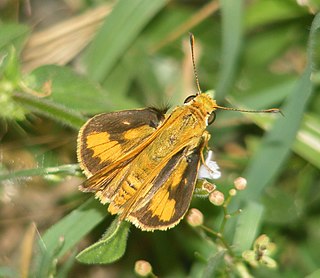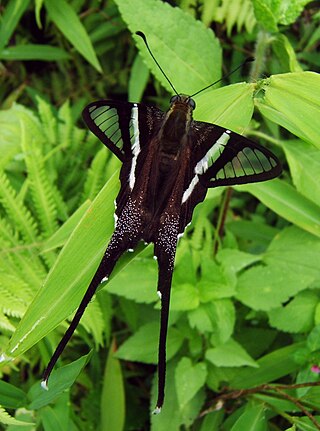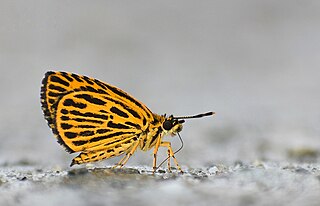
Parantica aglea, commonly known as the glassy tiger, is a butterfly found in the Indomalayan realm. The species is a member of the Danainae subfamily of the Nymphalidae family.

Celaenorrhinus ambareesa, commonly known as the Malabar spotted flat, is a species of hesperiid butterfly found in India.

Hasora chromus, the common banded awl, is a butterfly belonging to the family Hesperiidae which is found in the Indian subcontinent, Southeast Asia and Australia.

Quedara basiflava, the yellow-base flitter or golden flitter, is a butterfly belonging to the family Hesperiidae and is endemic to India's Western Ghats.

Telicota colon, commonly known as the pale palm dart or common palm dart, is a species of butterfly in the family Hesperiidae. It is found from India to Australia.

Abaratha alida, the yellow spotted angle or Alida angle, is a butterfly belonging to the family Hesperiidae. It is found in India, Sri Lanka, Myanmar, Thailand, Vietnam, Laos, Hainan and southern China. It was first described by Lionel de Nicéville in 1891.

Celaenorrhinus leucocera, commonly known as the common spotted flat, is a species of butterfly belonging to the family Hesperiidae. It is a common butterfly generally found in the wet forested hills of southern Asia, from India and the Himalayas east through Indo-China. The upper surfaces of the wings are dark brown with white bands and small white spots towards the tip of the wings.

Spialia galba, the Indian grizzled skipper, is a hesperiid butterfly which is found in South Asia and parts of Southeast Asia.

Lamproptera curius, the white dragontail, is a species of swallowtail butterfly native to parts of South Asia and Southeast Asia where it is common. It belongs to the dragontails genus, Lamproptera, of the swallowtail family, Papilionidae.
Spectroreta is a monotypic moth genus belonging to subfamily Drepaninae erected by Warren in 1903. Its only species, Spectroreta hyalodisca, was described by George Hampson in 1896.

Pseudacraea hostilia, the western incipient false acraea, is a butterfly in the family Nymphalidae. It is found in Sierra Leone, Liberia, Ivory Coast and western and central Ghana. The habitat consists of wetter forests.

Celaenorrhinus putra, commonly known as the Bengal spotted flat, is a species of butterfly in the family Hesperiidae. It is found in India and south-east Asia.

Episcepsis demonis is a moth of the family Erebidae. It was described by Herbert Druce in 1896. It is found in Panama and Peru.
Episcepsis lenaeus is a moth of the family Erebidae. It was described by Pieter Cramer in 1780. It is found from Mexico to the Guianas.
Episcepsis capysca is a moth of the family Erebidae. It was described by William Schaus in 1910. It is found in Costa Rica.
Episcepsis lamia is a moth of the family Erebidae. It was described by Arthur Gardiner Butler in 1877. It is found in the Amazon region, Guatemala and Costa Rica.

Episcepsis thetis is a moth of the family Erebidae. It was described by Carl Linnaeus in 1771. It is found in Panama and Venezuela.

Episcepsis sixola is a moth of the family Erebidae. It was described by William Schaus in 1910. It is found in Costa Rica.

Letis hercyna is a species of moth in the family Erebidae. It was first described by Dru Drury in 1773 from Jamaica.

Ochus subvittatus, the tiger hopper, is the only species in the monotypic moth genus Ochus of the family Hesperiidae. The genus was erected by Lionel de Nicéville in 1894. The species was first described by Frederic Moore in 1878. It is found in the Khasi Hills and Naga Hills of India, Myanmar, Thailand, Laos, Vietnam and Yunnan.
















